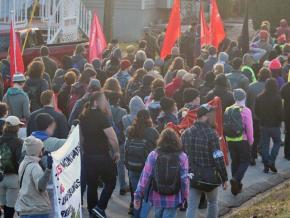We made the KKK stay away
The reports on how anti-racists kept the Ku Klux Klan from rallying at a notorious monument to the Confederacy.
A COALITION of anti-fascist protesters marched in opposition to a gathering on February 2 by the Ku Klux Klan in Stone Mountain, Georgia, the home of a massive carving of Confederate generals on an 800-foot-tall granite outcrop.
The park is visited by some 4 million people a year. It’s not just a memorial celebrating the Confederacy, but the site where the modern iteration of the Ku Klux Klan was established in 1915.
This is why in the spring of 2016, when white supremacist forces planned the “Rock Stone Mountain” rally, there was an enormous outpouring of protest.
In fall 2018, known alt-right activists Greg Calhoun and John Estes announced they would hold “Rock Stone Mountain 2” during the same weekend that Atlanta hosted the Super Bowl.
The park denied them a permit citing security concerns, and in a letter to organizers, the Stone Mountain CEO wrote that they did “not have the available resources to protect not only the members of your organization but the park employees and general public.”

The right initially remained determined to rally anyway, but as the day approached, it was clear the left-wing forces would far outnumber those celebrating the Confederacy. The organizers announced via Facebook that the event was canceled.
Also, shortly before the march was to occur, Stone Mountain Park officials announced that the park would be closed the entire day. Yet those who were determined to stand against white supremacy continued to organize.
ROCK STONE Mountain 2 ended up with no visible white supremacist presence anywhere while well over 100 anti-fascists staged a march through downtown Stone Mountain city.
Proclaimed as a “victory lap,” anti-racist marchers went through both residential and commercial areas of the 75 percent Black city near Atlanta. Participants reaffirmed that racists weren’t welcome in their communities.
Popular chants included “No hate, no fear, immigrants are welcome here” and “Black Lives Matter.” Residents came out of their homes to join in the demonstration.
At one point, the demonstration stopped outside the town’s visitors’ center. Organizers had made a piñata of a Klansmen filled with buttons with anti-racist slogans. The crowd called out to burn the piñata as others chanted “KKK stayed home today” and “Sandblast Stone Mountain.”
The cops pushed through the crowd and stomped out the burning piñata, but that was the only real interaction they had with protesters, most likely due to a fear of negative media attention on Super Bowl weekend.
When asked what made her attend, a protester named Caroline Ray talked about the importance of solidarity and presenting a united front against fascism. She had heard about the event through the jail support group she’s a part of, as well as friends from Food Not Bombs.
“The country as a whole is built on white supremacy, and that needs to be fought,” Ray said.
At the end of the protest, people congregated at the original starting point of the rally. An organizer from FLOWER United spoke, thanking people for coming out and saying, ““The seeds of anti-fascism planted in the response to Berkeley have blossomed across the country.”
Participant Sage Burns summed it up well:
It is important to celebrate this victory, and to learn from it that anti-fascist and anti-racist action can and does work. This is one of the biggest opportunities to make connections with the other sections of the left, and we will need to do so to see any major gains within our lifetimes. We need each other. If there is any hope for a wide-ranging socialist movement to once again engage this country, it will be done in making connections in united front fights, and in building networks of like-minded activists like those found in the campus anti-fascist networks of Ohio.


